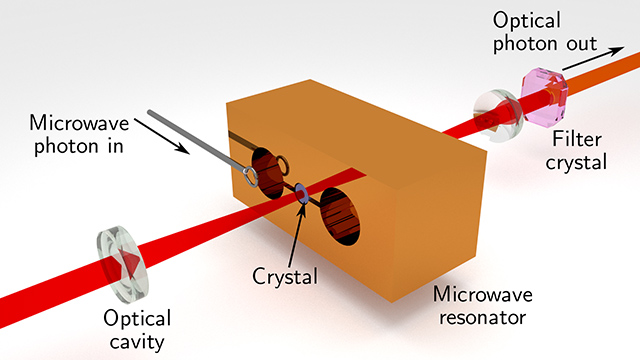Superconducting qubits have proven one of the most promising quantum computing systems, with the prospect of fast gates in a solid state system and easy manipulation and readout using microwave photons. However, there is currently no good way of storing or transporting microwave photons, which has impeded the scaling of superconducting qubits into large quantum computers, and means they cannot be integrated with quantum network technology.

Figure 1: Microwave-to-optical up-conversion using a rare earth crystal in both a microwave cavity and an optical cavity.
One of the most promising solutions to this problem is to simply up-convert the microwave photons to optical photons, where storage and transport technologies are state-of-the-art. Our collaborator Assoc. Prof. Jevon Longdell at the University of Otago has shown that this could be achieved using rare earth ions in solids. This approach involves exciting a microwave transition on the ions, then using an optical coupling beam to transfer the excitation onto an optical transition from which it is read out as an optical photon.
For quantum computing it will be necessary to up-convert a single photon with unit efficiency. This is a major challenge requiring a system with narrow linewidths and extremely strong coupling between microwave and optical transitions, as well as between the transitions and the applied microwave and optical fields. At ANU we are investigating the use of ferromagnetic rare earth crystals to achieve strong coupling. The collective spin excitations of these crystals are extremely strongly coupled to microwave fields while the high ion density ensures strong optical coupling. We are studying a range of different ferromagnetic crystals to understand how the crystal structure and magnetic ordering geometry affect the microwave-optical coupling and transition linewidths, with the goal of developing a material in which unit efficiency up-conversion is possible.